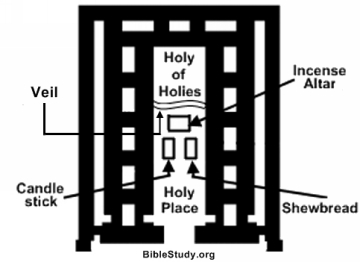Therefore, brethren, having confidence to enter into the true holiest by the blood of Jesus, By a new and living way, which He consecrated for us THROUGH THE VEIL (that is, His flesh) (Hebrews 10:19 - 20, HBFV throughout)
What is Paul trying to teach us? What and where is the veil he is referencing and why did Christ have to go through it? What does it symbolize, if anything? What does the blood of Jesus have to do with us entering the "true holiest?"
Nailed to the Cross
Around 9 a.m. on April 5, 30 A.D., at a place called Golgotha, Jesus was laid flat on a wooden pole. Large metal nails were driven through his flesh in order to fasten his body to the pole. The pole was then brought upright and secured so that he, like others who had been crucified, could publicly be shamed, mocked, suffer and die.

After six agonizing hours Christ declares the work God gave him to do was finished (John 19:28, 30). After loudly proclaiming that he was committing his spirit into the hands of his Father (verse 46) he dies. Three of the four gospel writers then record an unusual occurrence involving a veil in the temple.
And suddenly the veil of the temple was ripped in two from top to bottom (Matthew 27:51, see also Mark 15:38 and Luke 23:45)
The veil in question was actually a large, thick curtain that completely separated an area known as the Holy Place from a location called the Holy of Holies (which Paul called "the true holiest").
Holy of Holies
The Holy of Holies was the most sacred part of the temple and represented the very presence of the Almighty. When King Solomon erected the temple, it had within it the Ark of the Covenant (which contained the Ten Commandments), a flask of manna and Aaron's rod that budded (2Chronicles 5:10, Hebrews 9:4).
The Holy of Holies could only be entered by the High Priest once a year, on the Day of Atonement, so that he could sprinkle blood on the ark's mercy seat to atone for Israel's sins (Leviticus 16). At King Solomon's dedication ceremony of the temple, God manifested His presence and glory (sometimes referred to as skekinah) in the Holy of Holies.
It came to pass, as the trumpeters and the singers were as one, to make one sound to be heard in praising and thanking the Lord . . . saying, "For He is good, for His steadfast love endures forever," that the house was filled with a cloud, even the house of the Lord, So that the priests could not stand to minister because of the cloud, for the glory of the Lord had filled the house of God! (2Chronicles 5:13 - 14).
Meaning
Before the sacrifice of Christ, humans had to go through the temple priesthood in order to have a relationship with God. Moreover, only the High Priest (who represented all the people), on only one day, could directly be in God's presence through the veil.
Christ, at the moment of his death, completed his Father's will that he be the perfect "lamb of God" (see John 1:29, 1Peter 1:19, Revelation 5). His sacrifice paid for all the sins of humanity. The veil, therefore, separating the Holy of Holies from the rest of temple symbolized at least two things.
The veil represented our sins, which separate us from our Creator (Isaiah 59:2). It also symbolized Christ's flesh and blood, which had to be torn in order for us to be forgiven and gain access to God (Isaiah 50:6, 52:14, 53, Zechariah 12:9 - 10). The miracle of splitting the temple veil in two signified that direct access to the Father was now available.
Jesus, after his resurrection, ascended into heaven (John 20:17). Then, just like the earthly priest had to have blood in order to go "through the veil" into the Eternal's presence, he presented his sacrifice (blood) before God's throne.
But Christ Himself has become High Priest of the coming good things . . . Not by the blood of goats and calves, but by the means of His own blood, He entered once for all into the holiest (God's presence symbolized by the temple's Holy of Holies), having by Himself secured everlasting redemption for us (Hebrews 9:11 - 12)
Christ is man's true High Priest. His removing of the veil between our heavenly Father and us means we can directly access him anytime we have a need.
Having therefore a great High Priest, Who has passed into the heavens, Jesus the Son of God, we should hold fast the confession of our faith . . .
Therefore, we should come with boldness to the throne of grace (where the veil has been removed), so that we may receive mercy and find grace to help in time of need (Hebrews 4:14, 16).